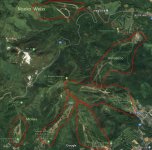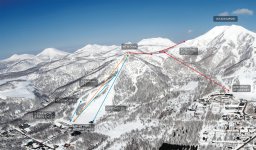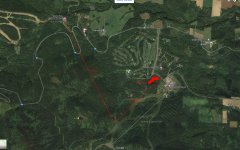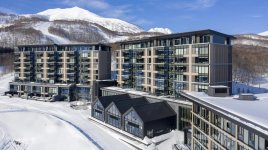Before getting into Europe, I'll mention Mt. Bachelor, which is similar to Niseko in topography. Long term average at 6,350 feet is 382 inches. I can't locate, but for a couple of years they measured at the top of Pine Marten about 1,300 feet higher and extra snowfall was only around 10%. This is similar to the difference at Alta between UDOT at the base and Collins mid-mountain.
This topic is one where your eyes often tell you at least as much as a table of stats. You rarely see the massive piles of snow at the base/parking areas of Park City, Jackson, Squaw* that you do at Bachelor, Mammoth and Niseko. *You occasionally see it at Squaw due to the high volatility. That applies also to the Cervinia base that we saw in January 2018.
As for Europe, keep in mind caveats the James mentioned. Some stats are annual only which means we don't know if time periods of measurement are consistent. Cervinia stats are annual for only 7-10 years:
200 inches at 6,724 foot base
285 at 8,380 feet
330 at 11,414 feet
That's skimpy data but I'd guess the relationship among those 3 elevations is reasonable.
The Swiss government has posted some 1980-2010 averages but no individual years.
Andermatt:
250 at 4,730 foot base
347 at 7,501 feet
Davos:
169 at 5,228 foot base
297 at 8,823 feet
Passes SE of St. Moritz:
125 at 5,897 feet
265 at 7,567 feet
The Austrian government also posts some 30 year averages but not so much within ski areas. This is the only elevation related comparison I can find.
Galtur 206 at 5,192 foot base
Obervermunt (Silvretta) 325 at 6,691 feet
The northern Tyrol has that microclimate (Damuls, Warth) with very high snowfall at relatively low elevation.
Some but not all of the French data is monthly as well as annual.
Les Menuieres 152 at 5,937 feet
Val Thorens 252 at 7,544 feet
The above are from the westernmost of Trois Vallees. The far eastern valley:
Courchevel 245 at 6,068 feet
Saulire 327 at 8,856 feet
Continue east close to the Italian border and you get:
La Rosiere 270 at 6,135 feet
Tignes 285 at 6,888 feet



